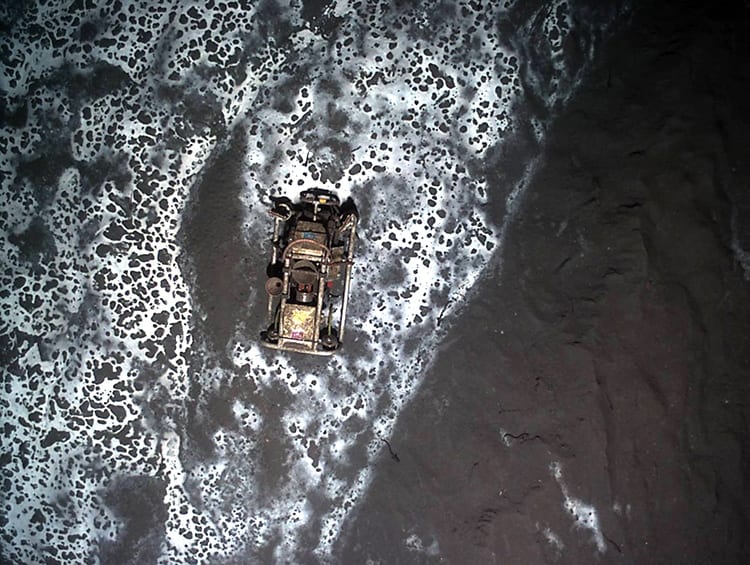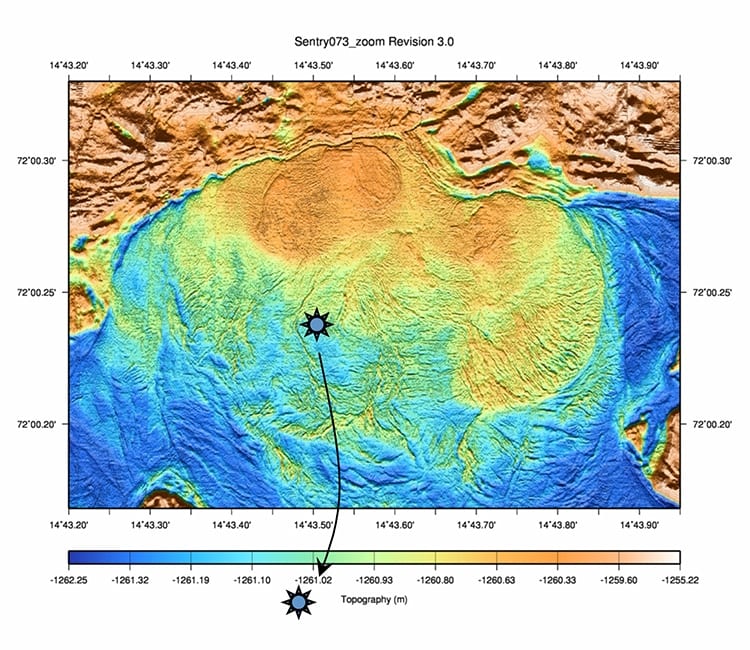More Methane from the Deep Sea: Mud volcanos as methane source
November 11, 2014
The mud volcano Haakon Mosby in the Barents Sea near Norway annually emits several hundred tons of methane, a potent greenhouse gas. But do mud volcanoes like Haakon Mosby emit gas and mud continuously or do their emissions come from episodic eruptions?
A study by a research team, coordinated by the Max-Planck-Institute in Bremen, reports on the results of a long-term observatory in NATURE Communications. Over 431 days, they collected data on temperature, pressure and pH together with imagery of 25 eruptions of mud and gas. Some of these eruptions were so violent that the seabed topography was profoundly changed. They calculated that the mud volcano may emit 10 times more methane than previously assumed.
There are over 1000 known mud volcanoes on land, and a growing number, such as the Haakon Mosby Mud Volcano, are found in the sea, between 200 and 4000 meters depth. Scientists estimated that submarine volcanoes emit 27 million tons of methane—about 5 percent of the global emission. This may be an underestimation, as not all volcanoes are known and because they are not monitored by long-term observatories.
The long-term observatory
Mud volcano eruptions are rare events, and scientists had never before observed one in progress. To document the occurrence and frequency of eruptions, the scientists, led by Dr. Dirk de Beer, designed and built a device for long-term observations on mud-volcano eruptions (LOOME) and deployed it on the Haakon Mosby Mud Volcano at 1200 meters’ depth in 2009 using the deep sea robot Quest (MARUM). The volcano has a diameter of one kilometer but an elevation of only 10 meters. The LOOME experiment’s sensors were placed in the most active area at the center of the volcano and connected by cables to the observatory at its outer edge.
While the bottom water is ice-cold, inside the sediment the temperature increases rapidly. Dr. Tom Feseker (MARUM center for marine environmental sciences, University of Bremen): “At the center of the volcano we measured a temperature of 25oC just one meter below the surface. That heat is carried up from great depths by gas-rich fluids.”
LOOME’s thermometers showed several heat pulses; gas was liberated and elevated the seafloor in pulses by over one meter. The sediments slipped sideways over several hundreds of meters. After the series of eruptions, the seafloor subsided gradually to its original elevation.
10 times more methane than thought
Dr. Dirk de Beer from the Max-Planck-Institute for Marine Microbiology and scientific leader of the LOOME project explains: “The eruptions are driven by gas that originates from great depths. Also the heat destabilizes the gas hydrates in the surface of the volcano and the methane gets liberated. The gas finally reaches the water column. We calculated that to drive these eruptions, at least 10 times more gas is emitted than previously assumed. Most of the gas may not reach the atmosphere, but gets diluted in the seawater where it can be oxidized by aerobic bacteria.”
The team used detailed high resolution bathymetric maps made in 2003 and 2006 using ROV Victor, and in 2010 by the WHOI-operated AUV Sentry, led by WHOI Scientists Chris German and Dana Yoerger to track changes in the seafloor bathymetry. Sentry was also used to collect extensive down-looking photography that helped reveal the direction of flow of the mud, post-eruption, and equipped with WHOI Scientist Rich Camilli’s TETHYS in situ mass spectrometer, which was used to measure CO2 and methane flares above the mud volcano’s most active area. Remarkably, no signs were observed that mud had flowed out beyond the perimeter of the volcano. That means that once it has released it gas, the moving mud must sink and be recycled inside the volcano. The horizontal movement of the mud could be reconstructed precisely, because a 20-meter-long, 2-ton temperature lance embedded at the center of the mud volcano in 2009, was found to have moved by 165 meters by October 2010.
Typically, it is believed that a large part of the methane released from deep sites never reaches the atmosphere, because it is mostly converted to carbon dioxide (CO2) by microbes at and close to the sea floor. But this “microbial filter” is very sensitive to disturbances by eruptions and only works efficiently when the gas flow is slow and steady. When gas flows quicly, as in the case of eruption pulses like those revealed here, the gas released may simply by-pass the filter and escape into the overlying water column.
An important conclusion of this study, therefore, is that the microbial filter is overwhelmed regularly by eruptions, and has no time to grow back in between. Prof. Dr. Antje Boetius, Chief Scientist aboard ship for the deployment and recovery expeditions, says: “We have learned a lot from the year-long observations. As it was the first of its kind, we have acquired unique data on the volcano and its influence on the environment. Since eruptions of such volcanoes can cause large avalanches and form significant sources of methane, we should deploy more long-term observatories.”
Request for information:
Dr. Dirk de Beer
Max-Planck-Institute for Marine Microbiology
Tel. +49 421 2028 802
dbeer@mpi-bremen.de
Dr. Tom Feseker
MARUM
Tel. 0421 218 – 65348
tfeseker@marum.de
Prof. Dr. Antje Boetius
Alfred –Wegener-Institute and Max-Planck-Institut for Marine Microbiology
Tel. +49 421 2028 860
antje.boetius@awi.de


